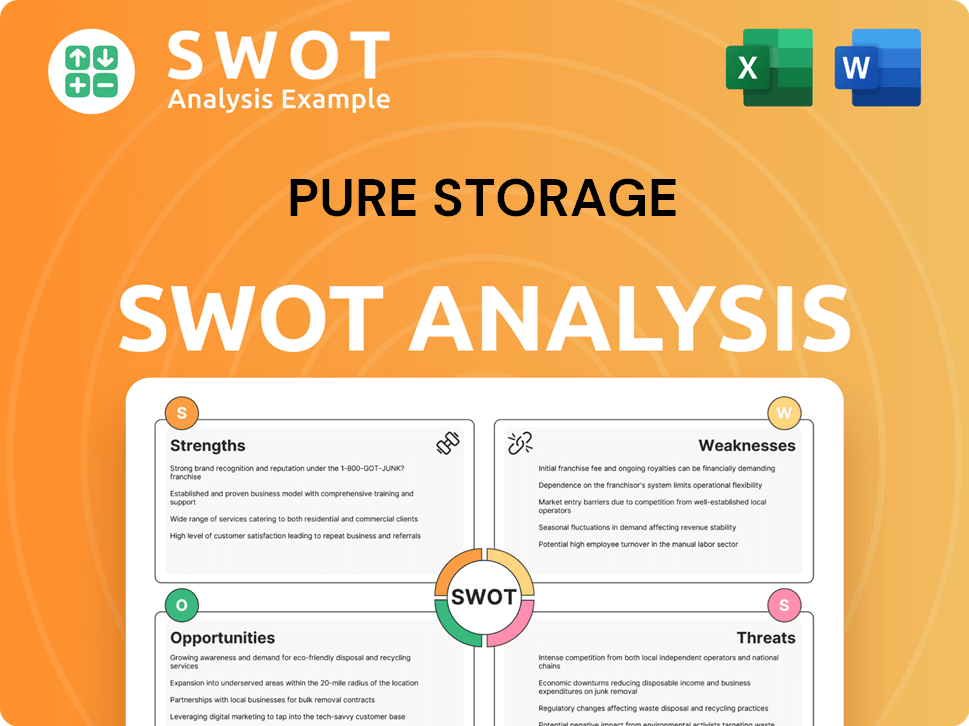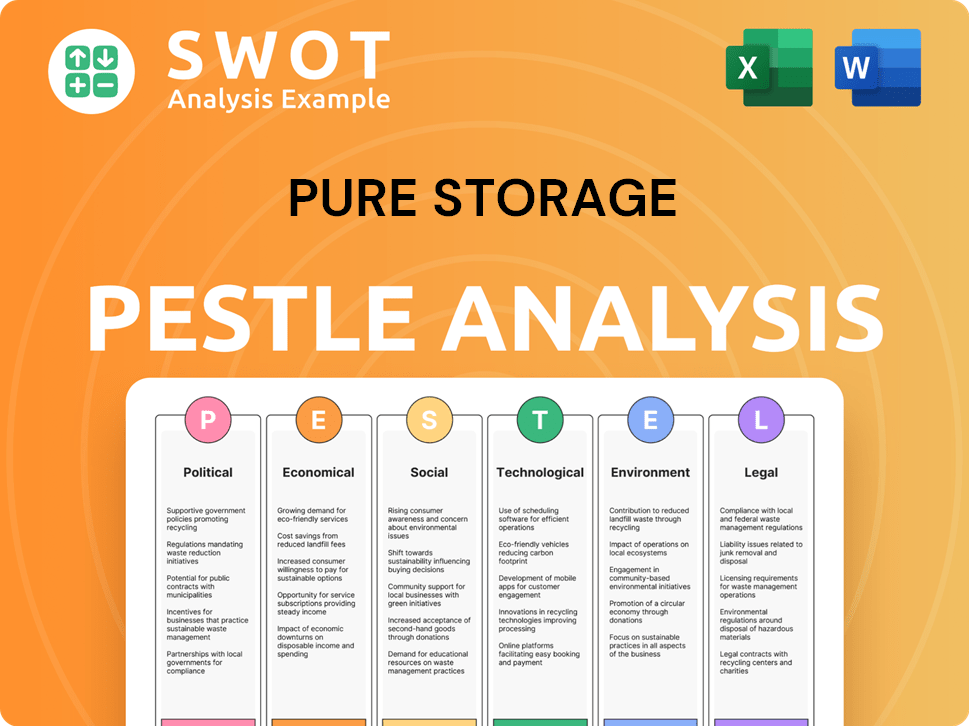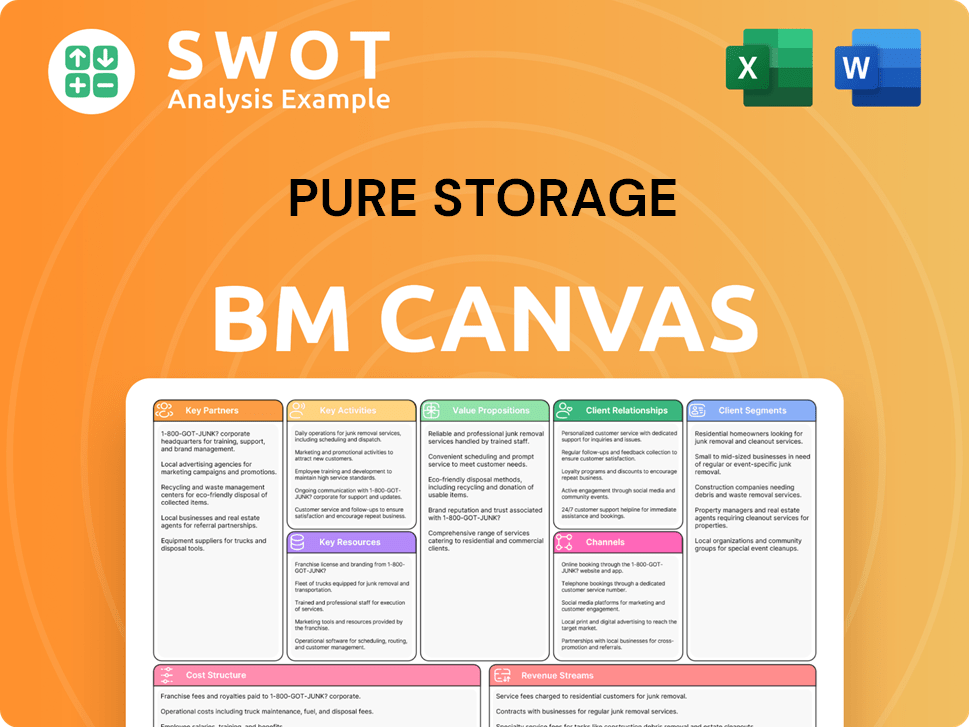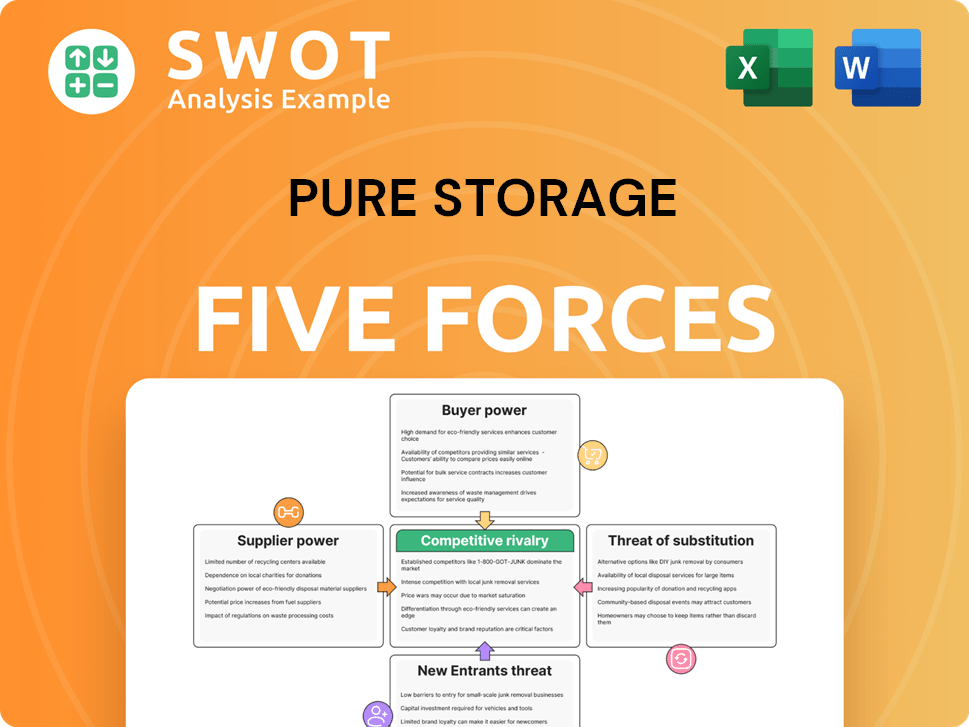Pure Storage Bundle
Who Really Owns Pure Storage?
Understanding a company's ownership structure is crucial for any investor or business strategist. Pure Storage, a leader in modern data storage solutions, has undergone a significant transformation since its founding in 2009. From its inception as a privately held startup to its current status as a publicly traded company, the evolution of Pure Storage SWOT Analysis reflects its growth and strategic shifts.

This exploration into Pure Storage ownership will uncover the key players shaping its future. We'll examine the shifts in Pure Storage company ownership, from the founders and early investors to the current landscape of shareholders, including institutional investors and key executives. Discover the dynamics behind Pure Storage's success and the individuals and entities that hold the reins of this innovative technology firm.
Who Founded Pure Storage?
The journey of Pure Storage, a company now known for its data storage solutions, began in 2009. Founded by John Colgrove and John Hayes, the company initially operated under the name Os76 Inc. It started its operations within the offices of Sutter Hill Ventures, a venture capital firm, marking the beginning of its venture into the tech industry.
Early financial backing was crucial for Pure Storage. The company secured an initial $5 million in its Series A funding round in January 2009. While the exact equity distribution among the founders at the outset isn't public, John Colgrove remains a significant shareholder.
The early ownership structure of Pure Storage involved a mix of founders, venture capitalists, and angel investors. These initial stakeholders played a vital role in shaping the company's direction and growth, setting the stage for its future in the competitive data storage market. Understanding the early ownership provides insights into the company's foundational vision and strategic partnerships.
Pure Storage attracted significant investment early on, which helped it grow and expand. The company's early backers included venture capital firms and angel investors, who saw potential in its innovative approach to data storage. These early investments were pivotal in supporting the company's growth trajectory.
- Following the initial funding, Pure Storage raised an additional $20 million in a Series B round in August 2010.
- When Pure Storage emerged from stealth mode in August 2011, it announced a successful Series C funding round, securing $30 million in venture capital.
- In May 2013, In-Q-Tel (IQT), the venture capital arm of the American Central Intelligence Agency (CIA), made an undisclosed investment in Pure Storage, alongside a technology development agreement.
- By August 2013, Pure Storage had accumulated a total of $245 million in venture capital investments.
As of recent data, John Colgrove holds a substantial stake in the company, owning approximately 11.60 million shares, which represents about 3.56% of the company. Early angel investors included VMware's co-founders, Diane Green and Mendel Rosenblum, and former Data Domain CEO Frank Slootman, who later joined Pure Storage's board of directors. The company's history is a testament to strategic investments and visionary leadership, which are also discussed in the Marketing Strategy of Pure Storage.
Pure Storage SWOT Analysis
- Complete SWOT Breakdown
- Fully Customizable
- Editable in Excel & Word
- Professional Formatting
- Investor-Ready Format

How Has Pure Storage’s Ownership Changed Over Time?
The ownership structure of the company has transformed significantly since its inception. Initially, the company secured substantial funding through several private investment rounds. A notable event was the Series E funding round in August 2013, which raised $150 million, with investments from public market investors. This round, along with previous funding, brought the total capital raised to $245 million, valuing the company at over $1 billion. Another significant funding round, the Series F in April 2014, secured $225 million, increasing the company's valuation to $3 billion.
The company's transition to a public entity occurred in October 2015 with its Initial Public Offering (IPO). This IPO involved offering 25,000,000 shares of Class A common stock. Following the IPO, the ownership shifted to a mix of institutional investors, insiders, and public shareholders. This shift introduced broader market influences on company strategy and governance. SEC filings and annual reports provide transparency into shareholding changes.
| Ownership Type | Percentage | Shareholders |
|---|---|---|
| Institutional Investors | 67.01% | FMR LLC, BlackRock, Inc., The Vanguard Group Inc., State Street Corp, T. Rowe Price Investment Management, Inc. |
| Insiders | 5.39% | John Colgrove (3.56%) |
| Public and Individual Investors | 27.60% | Various |
As of the latest data, the ownership of the company is primarily held by institutional investors, who own approximately 67.01% of the stock. Insiders, including executives and key personnel, hold around 5.39%, and the remaining 27.60% is held by public companies and individual investors. The major institutional shareholders include FMR LLC, BlackRock, Inc., and The Vanguard Group Inc. John Colgrove, a co-founder, remains a significant insider with 11.60 million shares, representing 3.56% of the company. Understanding the Target Market of Pure Storage is crucial for investors.
The company's ownership structure has evolved from private funding rounds to a public company with significant institutional investor involvement. The IPO in 2015 was a major turning point, leading to a diverse shareholder base.
- Institutional investors hold the majority of shares.
- Insiders, like co-founder John Colgrove, maintain a notable stake.
- Public and individual investors also play a role in the company's ownership.
- The shift to public ownership has brought increased transparency.
Pure Storage PESTLE Analysis
- Covers All 6 PESTLE Categories
- No Research Needed – Save Hours of Work
- Built by Experts, Trusted by Consultants
- Instant Download, Ready to Use
- 100% Editable, Fully Customizable

Who Sits on Pure Storage’s Board?
The current board of directors at Pure Storage plays a vital role in the company's governance. The board's structure includes three classes, each serving staggered three-year terms. This setup ensures continuity and leverages accumulated experience. At each annual stockholders' meeting, successors to expiring terms are elected. The board must have a majority of independent directors, aligning with the New York Stock Exchange (NYSE) listing standards, which supports effective oversight and decision-making processes. The CEO is expected to be on the board, and other management members may also be appointed to provide relevant expertise, as detailed in the company's proxy statements.
The board's composition and the voting power of Pure Storage shareholders are critical aspects of the company's structure. The board's composition and the voting power of Pure Storage shareholders are critical aspects of the company's structure. Information on director nominees and voting procedures for upcoming annual meetings can be found in proxy statements, such as the DEF 14A filed on May 2, 2025. This structure ensures that the company's governance remains robust and responsive to shareholder interests.
| Board Member | Title | Background |
|---|---|---|
| Charles Giancarlo | Chairman of the Board | Former EVP and Chief Technology Officer at Cisco Systems. |
| Scott Dietzen | Director | Former CEO of Pure Storage. |
| Amitabh Srivastava | Director | Partner at Khosla Ventures. |
Regarding the voting structure, Pure Storage initially had a dual-class share structure at its IPO in 2015. Class A common stock had one vote per share, while Class B common stock had ten votes per share. This structure concentrated voting control with Class B common stock holders, including executives and directors. However, the dual-class structure had a time-based sunset clause, and it converted to a one-share, one-vote system in 2018. Currently, each holder of common stock has one vote per share. This transition to a single-class voting structure significantly altered the distribution of voting power, promoting a more equitable say for all Pure Storage shareholders. For more insights, consider reading about the Growth Strategy of Pure Storage.
Understanding the Pure Storage ownership structure is crucial for investors and stakeholders. The company's governance is shaped by its board of directors and the voting power distributed among its shareholders. The evolution from a dual-class to a single-class voting system has significantly impacted how Pure Storage investors influence company decisions.
- The board includes independent directors.
- The voting structure is now one share, one vote.
- Proxy statements provide details on director nominees and voting procedures.
- The company's structure promotes equitable shareholder influence.
Pure Storage Business Model Canvas
- Complete 9-Block Business Model Canvas
- Effortlessly Communicate Your Business Strategy
- Investor-Ready BMC Format
- 100% Editable and Customizable
- Clear and Structured Layout

What Recent Changes Have Shaped Pure Storage’s Ownership Landscape?
Over the past few years, there have been several key developments and shifts related to Pure Storage ownership. The company has shown strong financial performance, with revenue reaching $693.5 million in Q1 fiscal year 2025, an 18% increase year-over-year. Subscription services revenue also grew significantly, up 23% year-over-year to $346.1 million. This growth reflects positively on the company's ability to attract and retain Pure Storage investors.
The company has been actively returning value to its Pure Storage shareholders through share repurchases. In Q4 fiscal year 2024, approximately $21.4 million was returned to stockholders through the repurchase of 0.6 million shares. For the full fiscal year 2024, the company repurchased nearly 4.7 million shares, totaling approximately $135.7 million. As of May 28, 2025, the company had $152 million of buyback authorization remaining, and in February 2025, an additional $250 million was approved under its stock repurchase program.
| Metric | Value | Year |
|---|---|---|
| Revenue | $693.5 million | Q1 FY2025 |
| Subscription Services Revenue Growth | 23% YoY | Q1 FY2025 |
| Subscription ARR | Over $1.4 billion | Q1 FY2025 |
| Share Repurchases (Q4 FY2024) | 0.6 million shares, $21.4 million | Q4 FY2024 |
| Share Repurchases (FY2024) | Nearly 4.7 million shares, $135.7 million | FY2024 |
| Buyback Authorization Remaining | $152 million | May 28, 2025 |
Leadership changes include Kevan Krysler's departure as CFO, with Rob Lee succeeding him, effective August 1, 2025. Charles Giancarlo continues to serve as Chairman and CEO. The company is also focusing on strategic investments, particularly in the AI market. These moves indicate the company's commitment to growth and adaptation, which is crucial for Pure Storage company success. For more information about the company's journey, you can read this article about Pure Storage.
Pure Storage reported strong revenue growth in Q1 FY2025, demonstrating its market position and customer demand. The company's focus on subscription services is also paying off, with substantial growth in this area.
The company is actively returning value to shareholders through share repurchases. This strategy reflects confidence in the company's financial health and future prospects.
The transition in the CFO role is a notable change, with Rob Lee set to take over. Charles Giancarlo continues to lead the company as Chairman and CEO.
Pure Storage is investing in the AI market, indicating its commitment to innovation and adapting to emerging technologies. This will likely impact the company's Pure Storage ownership structure.
Pure Storage Porter's Five Forces Analysis
- Covers All 5 Competitive Forces in Detail
- Structured for Consultants, Students, and Founders
- 100% Editable in Microsoft Word & Excel
- Instant Digital Download – Use Immediately
- Compatible with Mac & PC – Fully Unlocked

Related Blogs
- What are Mission Vision & Core Values of Pure Storage Company?
- What is Competitive Landscape of Pure Storage Company?
- What is Growth Strategy and Future Prospects of Pure Storage Company?
- How Does Pure Storage Company Work?
- What is Sales and Marketing Strategy of Pure Storage Company?
- What is Brief History of Pure Storage Company?
- What is Customer Demographics and Target Market of Pure Storage Company?
Disclaimer
All information, articles, and product details provided on this website are for general informational and educational purposes only. We do not claim any ownership over, nor do we intend to infringe upon, any trademarks, copyrights, logos, brand names, or other intellectual property mentioned or depicted on this site. Such intellectual property remains the property of its respective owners, and any references here are made solely for identification or informational purposes, without implying any affiliation, endorsement, or partnership.
We make no representations or warranties, express or implied, regarding the accuracy, completeness, or suitability of any content or products presented. Nothing on this website should be construed as legal, tax, investment, financial, medical, or other professional advice. In addition, no part of this site—including articles or product references—constitutes a solicitation, recommendation, endorsement, advertisement, or offer to buy or sell any securities, franchises, or other financial instruments, particularly in jurisdictions where such activity would be unlawful.
All content is of a general nature and may not address the specific circumstances of any individual or entity. It is not a substitute for professional advice or services. Any actions you take based on the information provided here are strictly at your own risk. You accept full responsibility for any decisions or outcomes arising from your use of this website and agree to release us from any liability in connection with your use of, or reliance upon, the content or products found herein.